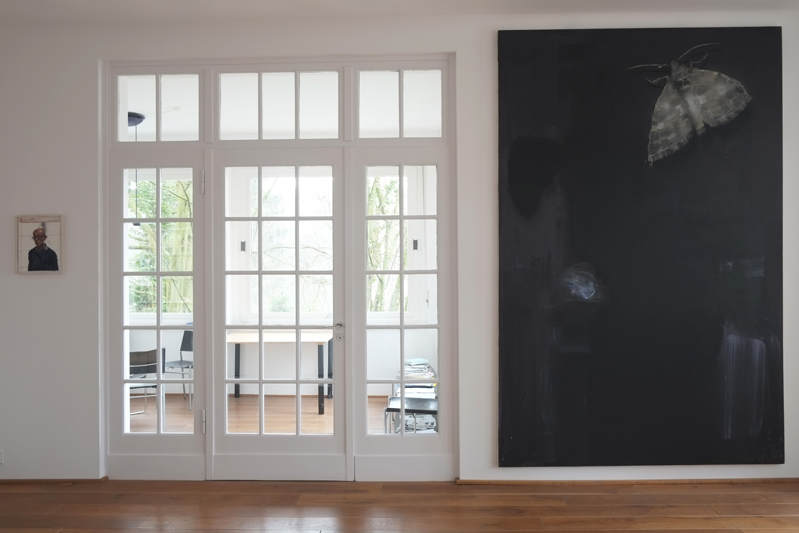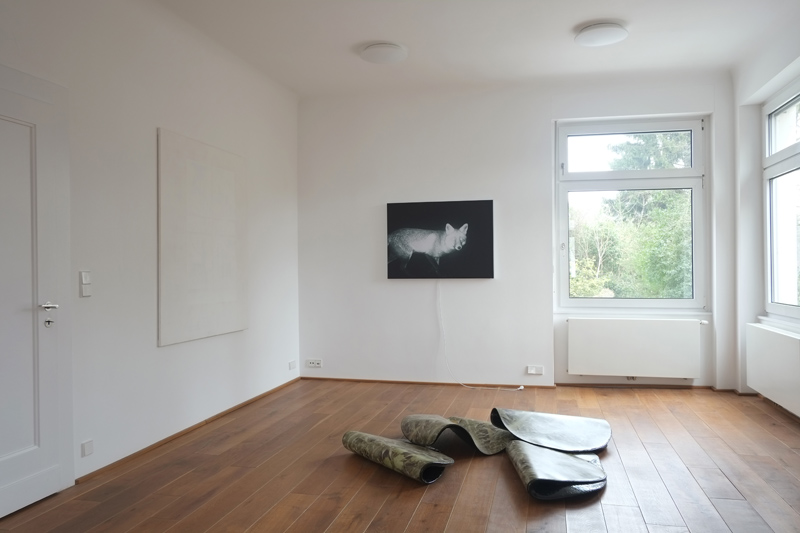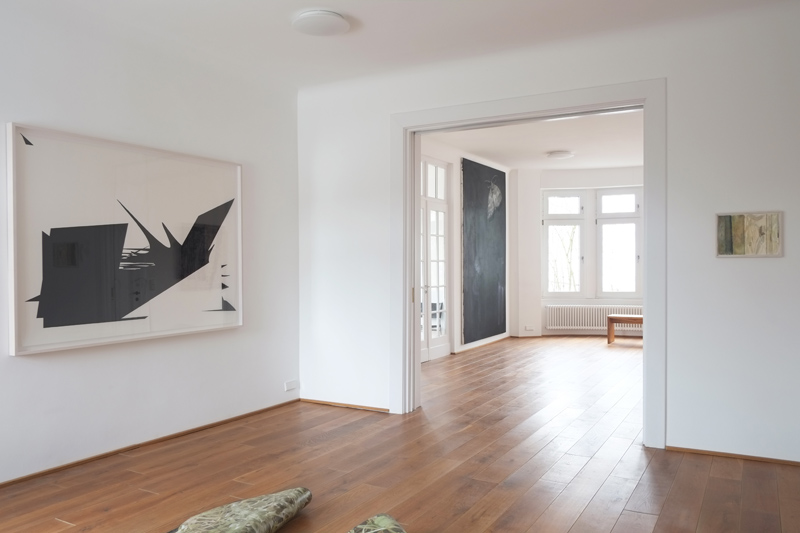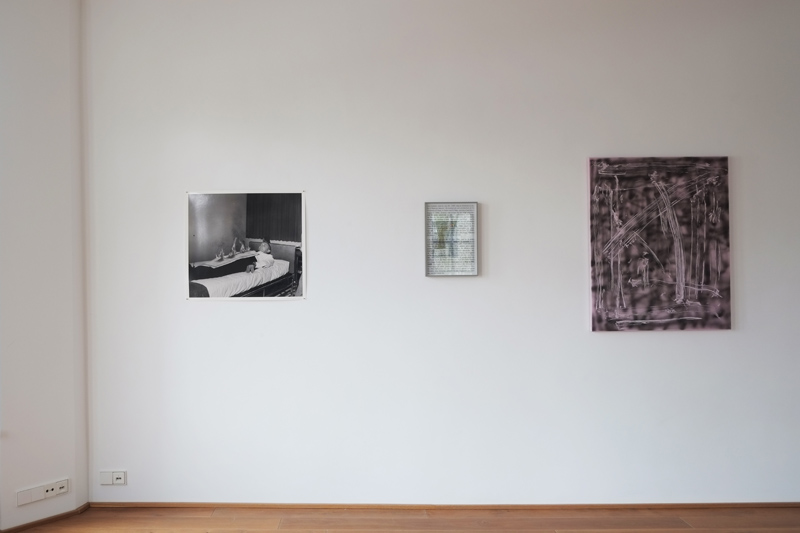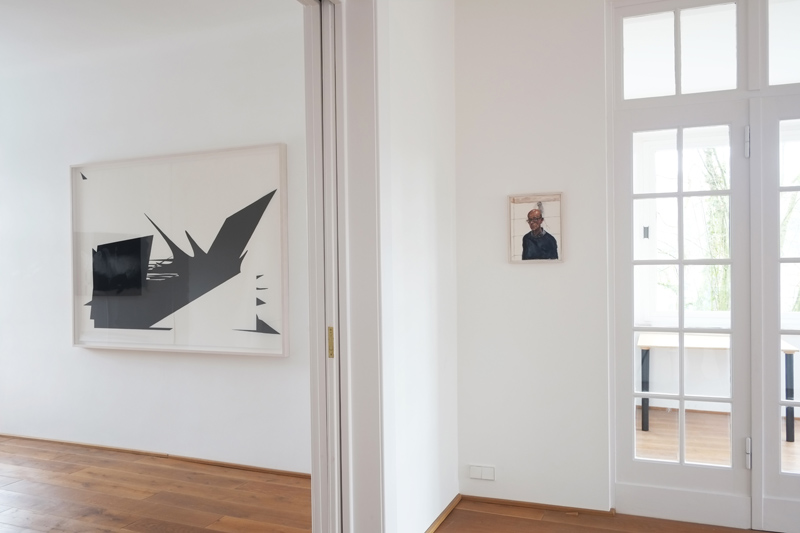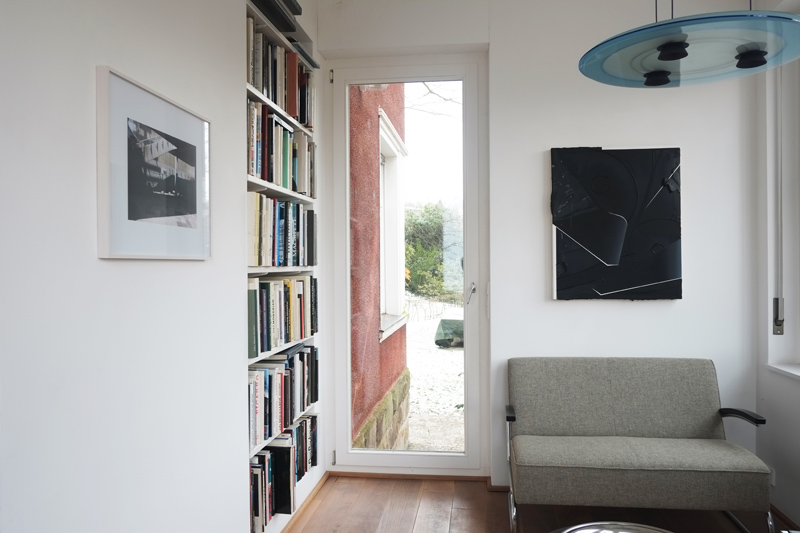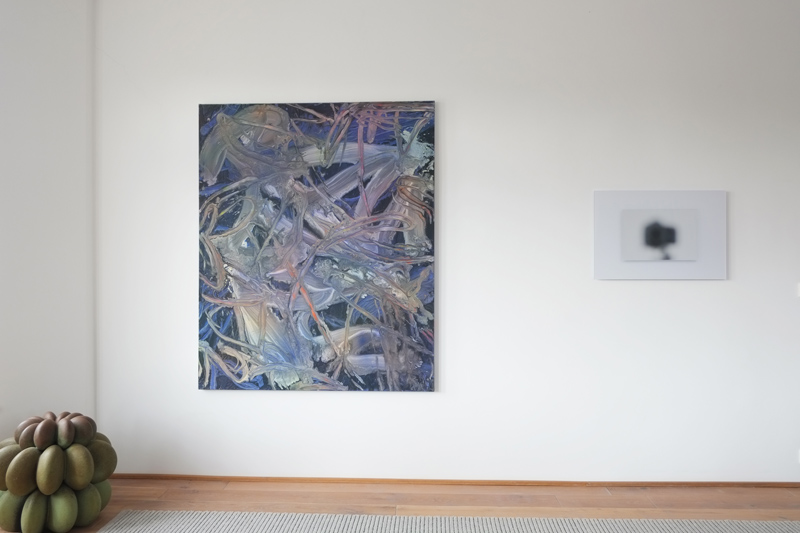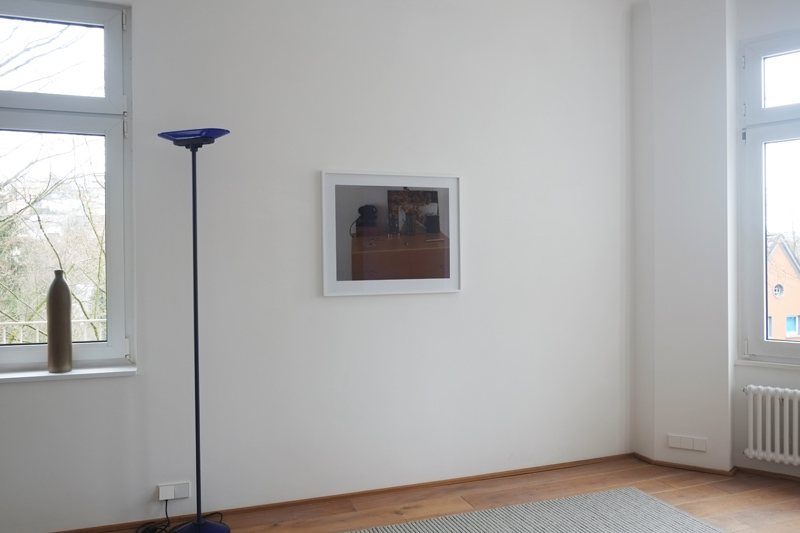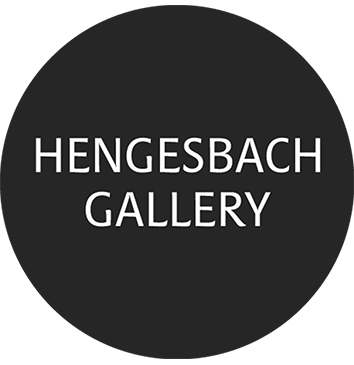Frank Ahlgrimm, Peter Bösenberg, Alex Hanimann, Dieter Kiessling, Anthony McDonald, Christopher Muller, Moritz Neuhoff, Christine Rusche, Björn Siebert, Nikola Ukic, Markus Willeke
March 6 – May 4, 2018
We wish for art to describe something of which we ourselves have only a vague idea. But can art also describe situations that are entirely puzzling to us because they are too complex or too indeterminate, too multilayered or contradictory, too threatening or alien and therefore present us with too much resistance?
In our exhibition, we aim to explore precisely this question. We present both figurative works whose depiction of reality does not point in a clearly interpretable direction, as well as abstract works that carry an underlying ambiguity and sense of threat.
Certainty is a value that is central to our sense of life. We assume that our senses provide us with certainty about the world, and that the world itself has stability and consistency. We therefore initially assign uncertainty to the future, because the future is open. If we cannot deal with this openness, we wish for the present to remain constant as the present, that the certainty in our lives does not disappear. We tend to see surprising developments as exceptions to our stable present. That the present itself may not be so certain is something we would rather not acknowledge—we prefer to turn to our stable habits instead.
That we ourselves are a mystery, that we do not know what is happening to us or how we should position ourselves in certain situations, is interpreted as a temporary irritation that we hope will soon pass.
We have selected quite different artworks for our exhibition, works that consciously differ in their tone and challenge each other. These different tones also affect the way we, as viewers, are addressed.
Uncertainty does not exist in the world without relation; it lies in the relational space between the world and ourselves. This relational space becomes increasingly complex over the course of human history, because both our experiences of the world and of the self change in their interplay. Neither what we understand as the world nor what we understand as the self today can be compared with that of two hundred years ago.
That is why there will be no stable viewer in our exhibition. Instead, the viewer will be addressed in very different ways by the individual works and must find their place in very different constellations. These can be cheerful, humorous, strange, astonishing, incomprehensible, threatening, or almost imperceptible.
In Frank Ahlgrimm’s work, the threat of the material emerges from its various textures. His Cuts series is dominated by the contrast between impasto dark paint, smooth dark surfaces from which a light appears, and sharply incised narrow geometric white grooves that force an uncanny spatiality onto the flat black—as a narrow window to something other—spatiality that also twists in different directions. What can we trust here? The dense matter, the gentle unfolding, or the cutting process—all united in the tightest of spaces?
Peter Bösenberg observes our surrounding reality with his camera instrument. He is fascinated by the fact that this surrounding reality is generally perceived as a given and mostly without irritation. But when Bösenberg’s eye is properly focused, and when this eye is precisely attuned to the appearance of light as the condition for all visibility, then this surrounding reality no longer appears in the resulting images as a neutral space filled with various things. The things are instead placed within a network of relations that seems incomprehensible or absurd to us, and they begin to exert emotional pressure or emotional suggestions upon us, causing our certainties to fade away.
Alex Hanimann repeatedly discovers constellations in our world that do not seem to function according to predetermined rules and that subvert our expectations of predictable behavior. Years ago, he came across his first trail camera images, which in their visual form disrupt the usual relationship between apparatus and subject. The apparatus here induces a sense of shock, destroys the certainty of being unobserved, and paradoxically enforces the otherwise avoided confrontation between the strange creature and ourselves. In a forced moment, we gaze upon a being that, although we are not present at all, fixes and mesmerizes us with its accentuated eyes. At the same time, the scene in which this violent confrontation occurs is displaced into the indeterminate and unclear.
Dieter Kiessling’s works revolve around the various forms of self-assurance. Our most natural form of assurance about our surrounding world is our vision. We can direct our vision, move it into and around the world, and focus it on specific things. What is required to fixate on something near or far is not something we speculate about, because these capabilities seem self-evident to us. We can look down at ourselves, but we cannot see ourselves seeing. For that, we need tools. The earliest tool was reflective water surfaces. Later, we were able to produce metallic glass surfaces as mirrors, and later still, devices that can look at us. Eventually, devices that can not only look at us but also fixate us. Can devices also see and fixate themselves? If we let them look into a mirror, will they know whether to fixate on the glass pane with the sharp edge or on their image in the pane? How do we assure ourselves of access in our effort for self-assurance?
Anthony McDonald focuses on simplicity. But is the simple really simple? We see a tree in the sunlight. At a distance from both it and ourselves, we see its shadow. Where is the shadow located? It cannot stand on its own like the tree. It needs a surface, a carrier on which it falls. This surface can be outside in the world, but it can also be spatially separated from the shadow—inside a house, where light enters through a window. The shadow on the interior wall, however, is suddenly no longer just the shadow of the tree, but also the shadow of the window frame, which merges with the shadow of the tree. Have the two shadows entered into a relationship, and how do they relate to the wall? Has the shadow altered the wall? Has the color of the wall entered into a relationship with the shadow, slowly fading in the light? What is fleeting, what is imaginary, and what is stable?
Christopher Muller explores the diversity of relationships in our everyday lives. What do we perceive from our immediate surroundings, and how are we in contact with them? We perceive this environment and yet at the same time overlook it. While we are oriented within it, the subtle relationships that form within it often pass us by—we lack the concentration to look more closely, to adjust our perspective, and to focus. We single things out when we are in search mode; we relate individual elements to others when we are in organizing mode. But can we detach ourselves from these modes of interest and gain a more general view of the web of relations in our environment? Does the familiar glance in the mirror only bring forth the familiar? Does the open gaze into my surroundings show only the present, or is the past also included? In that open gaze, don’t various relations to myself, my life, my time emerge—showing how my environment unfolds for me and, at the same time, hides from me?
Moritz Neuhoff constantly invents new processes of layering structures in his alchemistic painting studio, aiming to bring the decisive pictorial factors—such as color movement, color light, and color space—into ever-changing relationships. These processes do not seem to be controlled, although they also do not appear diffuse or chaotic. They do not condense into configurations of meaning, yet they are not devoid of meaning either. The movements of paint emit an energy that draws us in as viewers, allowing us to immerse ourselves through the unusual use of color and atmospheric light, without arriving at a clear understanding—because the various spatial levels seem to tell us different things. These spatial levels interlock without merging. We are unable to determine whether they relate to each other organically or inorganically, or whether they are processes of our tangible world or of an intangible micro-world brought to light.
Christine Rusche structures flat surfaces while simultaneously designing spaces. She pushes black paint outward and, at the same time, inserts the white void as a counterforce to the black, so that we cannot determine whether the weight of the black can exist at all without the force of the glaring white. The black tends to solidify into a body, yet this integrity is immediately taken from it by the white. The black uses hard geometric lines to assert its contour as something unassailable and artificial—as a product of our intellect. But since the black lacks internal differentiation, its contour literally leads into emptiness. It emerges from a broad volume, tapers to a point, only to curve slightly at the tip and fall back into the volume. Elsewhere, however, it has had the breath taken from it by the incisive white and has been scattered into the margins—an unending surge of tangible and intangible forces clashing against one another.
Björn Siebert is a lover of pictorial riddles. For him, they arise from the meticulous tracing of contradictory, intertwined human actions. By actions, we understand human sequences of movement that lead from an initial constellation to a changed outcome. In the images that Siebert is interested in, the transformation of the initial constellation has indeed begun, but in the course of this change, the structure of action has lost its goal, and all one can observe is that the event drifts into a meaningless constellation. Our reaction as viewers is one of incredulous amazement, humorous laughter, or a sense of oppressive absurdity.
Nikola Ukic sets artificial, virtually manipulated masses into motion in order to wrest from them a physically organic appearance. In his sculptures, polar forces collide and enter into a confrontation with one another. The artificial lies in the chemical processes of his preferred material, polyurethane, which, in its expansive formation, contains something unforeseen—something fundamentally processual, in constant flux, unfinished, and thus opposed to a fixed form. This artificiality is emphasized by the material’s glossy black color, which we do not encounter in nature. Yet this artificiality is paired with a physical volume that is familiar to us from our own bodies or from nature. In the case of the exhibited sculpture, these are enormous leaf-like forms that have curved under the influence of external forces. These leaf forms are both projection surfaces and boundaries for mediated images of natural densities—specifically, a field of interwoven thistles. The artificial expansion contends with natural growth. It is mediated by human bodily shaping and remains open-ended, as a possible cyclical sequence.
Markus Willeke is one of the increasingly rare painters who engage with the essential components of our present reality. In his work, there is a balance between, on the one hand, wresting images from the speed, transience, and fragility of our world, and on the other hand, condensing the essence of painterly practice through a new engagement with the difficult-to-control fluid and viscous. In this sense, he is always simultaneously captivated by the painterly surface in its expanse and by the artificiality of real surfaces in our world. Glass panes are almost the prototype of artificial surfaces. Can one paint glass panes, turn them into images? They can only be painted by making them tangible while allowing them to retain their intangibility. They are inherently dark, and yet they let light pass through. They can capture the innocuous, the nocturnal wanderer. Where is it going? Is it outside, or is it inside with us? What is it? Merely fine dust—or a being, shifting between fluttering restlessness and silent waiting for the unknown?
Installation Views
